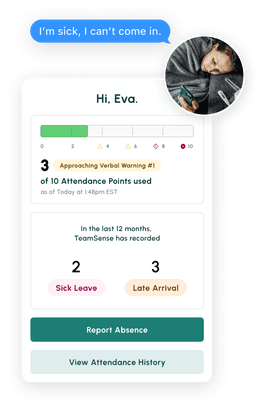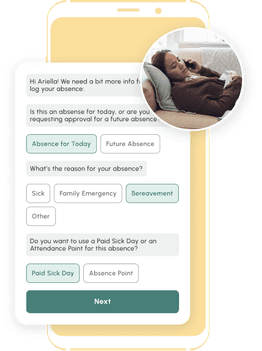When to HR with AI (and When Not To)!
Table of Contents
- What is Employee Absenteeism?
- What is the Absenteeism Rate Formula?
- How to Use the Absenteeism Rate Formula
- Absenteeism Rate Formula Examples
- How to Use the Annual Absenteeism Rate Formula
- Annual Absenteeism Rate Formula Examples
- Why is the Absenteeism Rate Formula Important?
- What is the Average Absenteeism Rate?
- What is an Acceptable Absenteeism Rate?
- How to Reduce Your Absenteeism Rate
- Start Tracking Absences with TeamSense
If you’re not a math junkie, you might hear the phrase “absenteeism rate formula” and run in the opposite direction. It's a pretty safe bet that formulas and math problems aren’t a favorite hobby for most people (no judgment if that’s how you like to pass the time, though).
But here’s the thing—if you want to get to the bottom of the absenteeism rate at your company, you’re going to have to crunch a few numbers. But don’t worry. It’s nothing you can’t handle. We’ll walk you through everything you need to know about calculating your business's employee absenteeism rate formula.
What is Employee Absenteeism?
Before we get too far, let's first cover what absenteeism is. Absenteeism is when a team member makes a habit of being absent from work (usually without giving a reason or notice).
Excessive absenteeism can chip away at your productivity, profits, and overall team morale. When employees are absent unexpectedly, the rest of your team has to pick up the slack. This can lead to burnout and exhaustion for your employees that are left behind to cover for the person who is absent for the day.
What is the Absenteeism Rate Formula?
The absenteeism rate formula calculates the percentage of time a team member has been absent from work during a specific amount of time.
Could you just pull out your Excel spreadsheet and compare it to how many days a specific team member has been absent for the month? Sure. But using the absenteeism rate formula is more accurate if you want to get some real data on the absenteeism rate.
How to Use the Absenteeism Rate Formula
All you have to do is get the number of absences during a specific period of time, divide it by the total amount of working days (don’t count weekends or holidays), and multiply that answer by 100.
Did we lose you once we started talking about formulas? Don’t tune out just because we used math terms like “multiply” and “divide.” It’s not as tricky as it might seem. Here’s the simple formula for how to measure absenteeism:
Total number of absences
_________________________ x 100 = X%
Total period of time

Is your call-in process terrible? Text reduces no-shows and absenteeism by up to 40%.
Don't believe us? Check out this case study to see how this 3PL benefited.
Absenteeism Rate Formula Examples
So, what does the absenteeism rate formula look like in real life? Let's walk through a few examples to give you a better idea.
Example 1
Lori hasn’t shown up for her shift six times during the last 30 working days. Using the absenteeism rate formula, let’s crunch some numbers to get her absenteeism rate.
6 ÷ 30 = .20 or 20%
That means Lori has been absent 20% of the time.
Example 2
Hector and his family caught Covid. Between his recovery and caring for his sick family, he’s been out for two full working weeks this month. He usually works five days a week, and there were 22 working days in August. We can calculate the sickness absence rate easily using the formula.
10 ÷ 22 = .45 or 45%
Hector’s absenteeism rate for the month is 45%.
How to Use the Annual Absenteeism Rate Formula
Wait—there’s another formula? That’s right! Let's say you want to get a full picture of the absenteeism rate over the course of an entire year. In that case, you need a slightly different absenteeism rate formula. Don’t worry—it’s pretty similar to the one we’ve already covered. Here’s what that looks like:
Number of absences during the year
_________________________ x 100 = X%
Number of working days during the year
To figure out how many working days you had this year, you have to take a few things out of the equation. Don’t count the PTO you give your employees each year, weekends, or company holidays.
It should look something like this but remember it will be different depending on the holidays and PTO at your company. Here’s an example of how to calculate your working days from 2021:
Working Days in 2021:
Days in the year: 365
Weekend days: 104
Public Holidays: 15
Company PTO: 15
Total working days = 231
Annual Absenteeism Rate Formula Examples
Now that we know how many working days we’re “working with” here, let’s run through an example of the annual absenteeism rate formula (say that three times fast).
Example
Remember Hector? Well, even though he was out for 10 days, he never missed another day all year (except for paid vacation and holidays). So, what does his absenteeism rate look like for the entire year?
10 ÷ 231 = .0432 or 4.32%
So even though Hector missed a chuck of days during one month, over the course of the entire year, his absenteeism rate was 4.32%.

No one wants to talk to their boss or a 1-800 stranger to call off. Text changes everything - Reducing No Call No Shows.
Why is the Absenteeism Rate Formula Important?
Understanding the absenteeism rate formula isn’t just about crunching numbers—it’s about identifying trends, reducing business costs, and improving workplace productivity. If left unchecked, absenteeism can drain company resources, frustrate employees, and create a ripple effect of lost productivity. Here’s why tracking your absenteeism rate matters:
1. It Helps Identify Patterns & Underlying Issues
A one-off sick day isn’t a big deal. But when absences start stacking up, it’s a red flag that something deeper is going on. By calculating the absenteeism rate formula regularly, businesses can spot trends early, such as:
- Seasonal spikes in sick days
- Employees frequently missing Mondays or Fridays
- Certain departments experiencing higher absenteeism rates
These patterns can reveal workplace challenges—burnout, disengagement, or even problems with company culture.
2. It Directly Impacts Business Costs & Productivity
Absenteeism isn’t just an inconvenience—it’s expensive. According to the U.S. Bureau of Labor Statistics, absenteeism costs U.S. employers $225.8 billion annually in lost productivity, wages, and administrative costs.
When employees frequently call out, it puts pressure on the remaining team, leading to:
- Increased overtime costs
- Lower morale among employees who must pick up the slack
- Higher risk of burnout and turnover
By tracking absenteeism rates, businesses can take proactive steps to prevent these losses.
3. It Ensures Compliance with Labor Laws
In many industries, absenteeism tracking isn’t just good practice—it’s a legal necessity.
- Regulations like the Family and Medical Leave Act (FMLA) and state-mandated paid sick leave laws require businesses to accurately track employee absences.
- A well-documented absenteeism rate ensures compliance and protects businesses from potential legal disputes related to unfair attendance policies.
4. It Helps Set Realistic Workforce Goals
HR teams and managers rely on absenteeism data to make informed staffing decisions.
- If absenteeism is consistently high, hiring temporary staff might be necessary to keep operations running smoothly.
- Tracking absenteeism rates also helps managers set fair attendance policies that balance productivity and employee well-being.
5. It Supports Employee Engagement & Retention
A high absenteeism rate is often a symptom, not the problem itself. It can indicate:
✅ Low job satisfaction
✅ Poor work-life balance
✅ Lack of flexibility in work schedules
When businesses use absenteeism rate data to address root causes, they can improve employee satisfaction and reduce turnover. Simple changes—like flexible scheduling, mental health days, or improved workplace policies—can significantly lower absenteeism rates.
What is the Average Absenteeism Rate?
The Bureau of Labor Statistics shows that the average absenteeism rate in the U.S. was 2.9% in 2021.1 And considering that those numbers reflect absences in a post-global pandemic world, they really could be a lot higher. Still, those absences come at a high cost too. Absenteeism adds up and costs employers in the U.S. $225.8 billion each year.2
What is an Acceptable Absenteeism Rate?
Generally, an acceptable absenteeism rate is anything right around the 1.5% mark. That said, it doesn’t mean a rate of 2.5% is a huge red flag, either. If a team member is out sick recovering from a col or the flu, that absenteeism rate is going to spike—and for good reason. And if you're calculating the absenteeism rate of specific employees, it’s important to look at the whole picture of their absence types.
If you thought we were going to say zero was the ideal absence rate, sorry. Having an absenteeism rate of zero might sound great on paper, but that’s just not real life. People go on vacation and take time off. People get sick and need to recover. Having zero team members absent just isn’t an attainable goal. Plus, you do actually want your team to take time off and maintain a healthy work/life balance. In the long run, that will benefit your employee’s well-being and the level of performance they bring to their work.
How to Reduce Your Absenteeism Rate
Everyone wants to find ways to have a lower absenteeism rate, right? The truth is that absences are a part of running a business and employing people. And when it all comes down to it, your company should be prepared to weather some absences from time to time.
But that doesn’t mean you have to stand back and just let absenteeism run wild. The good news is you can do things to help reduce absences at your company. Here are a few ideas to help you out.
1. Have a Clear Attendance Policy
If you don’t have a straightforward and easy-to-follow attendance policy—you need one. Having a policy in place will keep everyone on the same page about attendance expectations. You want your entire team to be fully aware of your attendance policy and know how to access it.
Your employees shouldn’t have to wonder what will happen to them if they don’t show up for work that day. They should know exactly what happens if they are absent without notifying you. Just knowing the attendance expectations (like a point system) can help cut back on absenteeism at your company.

2. Take Action—Both Good and Bad
This one is pretty simple—just back up your words with your actions. Set the trend at your company by addressing unscheduled absences head on. Believe it or not, just knowing that your company follows through on the attendance policy and takes action can help other employees avoid racking up excessive absences.
Have employees with perfect attendance this month? Celebrate them! Making a big deal out of good attendance will help the rest of your team see how important it is. Plus, a little healthy competition never hurts.
3. Help Your Employees Want To Come To Work
Another option up your sleeve? Make your workplace an enjoyable place to work at. That doesn’t mean you have to throw a pizza party every Friday or let your team bring their pets to work. All you have to do is treat people like people.
A healthy working environment where employees feel valued, seen, and heard can significantly impact finding a solution to absenteeism in the workplace. Pulse surveys, celebrating employee milestones, and praising employees for a job well done make a big difference and encourage employee engagement. If you want your team to come to work, don’t forget to invest in your people and take an interest in their lives. You can never go wrong by doing that.
Start Tracking Absences with TeamSense
If you’re ready to cut back on your absenteeism rate, it’s time to start using an easier attendance management system to track employee attendance. Absence management software to track absences is a simple way to help you get a snapshot of the attendance situation at your company. See who calls out the most, if they’re following the attendance policy, and see trends that pop up (like the same employee who always takes Monday off after a Sunday night football game).
TeamSense makes all of that simple by letting your team text to let your team communicate their absence to you. Relying on text to call off for the day lets your employees use a technology they’re familiar with—no apps to download, no company login information to remember. Send yourself a text to see it in action.
About the Author

Sheila Stafford, CEO of TeamSense & AI in HR Innovator
As CEO of TeamSense, Sheila Stafford is at the forefront of transforming HR for frontline teams through AI-driven solutions. With a commitment to enhancing employee relations and simplifying workforce management, Sheila leads TeamSense in pioneering advancements that empower both frontline employees and HR teams. Her visionary approach combines cutting-edge technology with a thoughtful focus on enhancing human connection; Sheila strategically implements AI where it adds the most value while recognizing the critical role of personal interaction and ensuring that human engagement remains central when it matters most. Under her leadership, TeamSense is redefining how companies support and engage their frontline teams for a more connected, efficient workplace.




